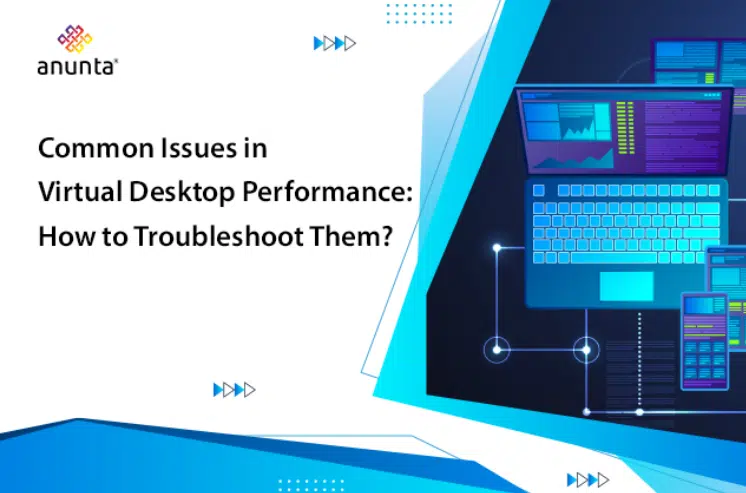Common Issues in Virtual Desktop Performance: How to Troubleshoot Them?

Virtual Desktop Infrastructure (VDI) has transformed how organizations manage remote work by providing secure and scalable solutions for accessing applications and data. However, as with any technology, VDIs can experience performance issues that hinder productivity. Understanding the common problems and how to troubleshoot them can help ensure a seamless virtual desktop experience.
Common Virtual Desktop Performance Issues and Their Solutions
Discover how to identify and resolve common performance issues in virtual desktop environments to ensure seamless user experiences.
1. Slow Login Times
Problem: Delayed logins are often caused by misconfigured group policies, large roaming profiles, or excessive startup applications.
Solution:
- Streamline group policy settings to reduce unnecessary load.
- Implement profile management solutions like FSLogix to optimize profile loading times.
- Minimize startup programs to ensure faster desktop initialization.
2. Poor Graphics Performance
Problem: Users may need help with lag or poor-quality visuals, especially when using graphics-intensive applications.
Solution:
- Enable GPU acceleration for tasks requiring high graphical processing power.
- Optimize display protocols like PCoIP or HDX based on network conditions.
- Upgrade virtual hardware to allocate more resources to the desktop.
3. Network Latency and Connectivity Issues
Problem: A sluggish network can lead to lag, screen freezes, or disconnections.
Solution:
- Prioritize network bandwidth for virtual desktops using Quality of Service (QoS) settings.
- Use monitoring tools to identify and resolve network bottlenecks.
- Deploy load balancers to distribute traffic across servers evenly.
4. Insufficient Resource Allocation
Problem: Overloading virtual desktops with fewer users or insufficient resource allocation can degrade performance.
Solution:
- Monitor resource usage (CPU, RAM, storage) and scale infrastructure as needed.
- Right-size virtual machines based on user workload requirements.
- Regularly audit user sessions to identify and address over-utilization.
5. Storage Bottlenecks
Problem: Slow storage performance can delay data access and application load times.
Solution:
- Use high-performance storage solutions like SSDs or hyper-converged infrastructure.
- Implement deduplication and compression to optimize storage efficiency.
- Monitor storage latency to address slow-performing drives promptly.
6. Application Compatibility Issues
Problem: Legacy or poorly optimized applications can be challenging in virtual environments.
Solution:
- Test applications in a virtual environment before deployment.
- Use application layering tools to separate apps from the OS, reducing compatibility issues.
- Provide users with alternatives or updates for problematic applications.
7. Session Freezing or Crashes
Problem: Sessions freezing or crashing is often due to driver conflicts, outdated software, or resource starvation.
Solution:
- Ensure all software and drivers are up to date.
- Use automated monitoring tools to detect and resolve resource conflicts.
- Regularly update hypervisor software to maintain stability and security.
Proactive Troubleshooting Tips
- Monitor Regularly: Use tools like VMware vRealize, Citrix Director, or Microsoft Endpoint Manager to monitor VDI health continuously.
- Enable Alerts: Set up automated alerts for unusual activity or performance degradation.
- Train Users: Educate users on best practices to reduce unnecessary strain on virtual desktops.
Conclusion
Addressing common virtual desktop performance issues requires a mix of proactive monitoring, proper resource allocation, and troubleshooting expertise. By understanding the root causes of these problems and implementing effective solutions, businesses can ensure a seamless VDI experience that enhances productivity and user satisfaction.
Partnering with an experienced provider like Anunta can help businesses optimize their VDI environments through advanced monitoring, end-to-end management, and tailored solutions that address unique performance challenges. Regular maintenance and updates to your VDI setup are essential to prevent recurring issues and future-proof your infrastructure. A well-optimized virtual desktop infrastructure is a cornerstone of a modern, agile workforce.
Frequently Asked Questions
Q: What causes slow login times in virtual desktops?
A: Misconfigured group policies, large roaming profiles, or excessive startup applications often cause slow logins. Streamlining group policies, using profile management solutions like FSLogix, and minimizing startup programs can help.
Q: How can I improve poor graphics performance in VDI?
A: To enhance graphics performance, enable GPU acceleration, optimize display protocols like PCoIP or HDX, and allocate more resources to the virtual desktop.
Q: What should I do about network latency affecting virtual desktops?
A: Use Quality of Service (QoS) settings to prioritize VDI traffic, monitor the network for bottlenecks, and deploy load balancers to distribute traffic evenly.
Q: Why do sessions freeze or crash, and how can I fix it?
A: Session freezes or crashes are often due to outdated software, driver conflicts, or resource shortages. Update software and drivers regularly, monitor resource usage, and ensure the hypervisor is current.
Q: How do I resolve storage bottlenecks in VDI environments?
A: Use high-performance storage like SSDs, implement deduplication and compression, and monitor storage latency to effectively address slow-performing drives.
